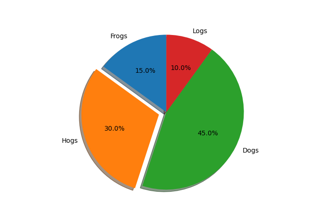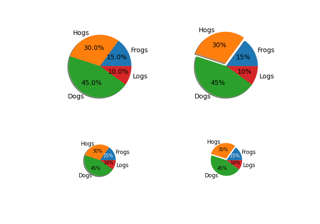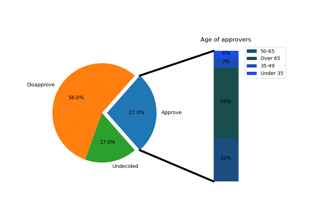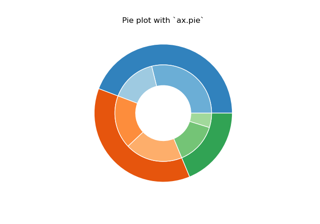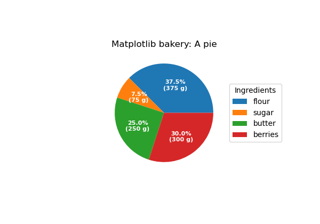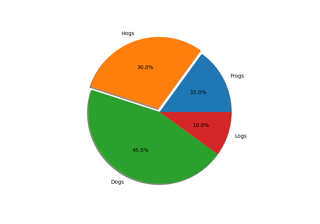matplotlib.axes.Axes.pie¶
-
Axes.pie(x, explode=None, labels=None, colors=None, autopct=None, pctdistance=0.6, shadow=False, labeldistance=1.1, startangle=0, radius=1, counterclock=True, wedgeprops=None, textprops=None, center=(0, 0), frame=False, rotatelabels=False, *, normalize=None, data=None)[source]¶ Plot a pie chart.
Make a pie chart of array x. The fractional area of each wedge is given by
x/sum(x). Ifsum(x) < 1, then the values of x give the fractional area directly and the array will not be normalized. The resulting pie will have an empty wedge of size1 - sum(x).The wedges are plotted counterclockwise, by default starting from the x-axis.
Parameters: - x1D array-like
The wedge sizes.
- explodearray-like, default: None
If not None, is a
len(x)array which specifies the fraction of the radius with which to offset each wedge.- labelslist, default: None
A sequence of strings providing the labels for each wedge
- colorsarray-like, default: None
A sequence of colors through which the pie chart will cycle. If None, will use the colors in the currently active cycle.
- autopctNone or str or callable, default: None
If not None, is a string or function used to label the wedges with their numeric value. The label will be placed inside the wedge. If it is a format string, the label will be
fmt % pct. If it is a function, it will be called.- pctdistancefloat, default: 0.6
The ratio between the center of each pie slice and the start of the text generated by autopct. Ignored if autopct is None.
- shadowbool, default: False
Draw a shadow beneath the pie.
- normalize: None or bool, default: None
When True, always make a full pie by normalizing x so that
sum(x) == 1. False makes a partial pie ifsum(x) <= 1and raises aValueErrorforsum(x) > 1.When None, defaults to True if
sum(x) >= 1and False ifsum(x) < 1.Please note that the previous default value of None is now deprecated, and the default will change to True in the next release. Please pass
normalize=Falseexplicitly if you want to draw a partial pie.- labeldistancefloat or None, default: 1.1
The radial distance at which the pie labels are drawn. If set to
None, label are not drawn, but are stored for use inlegend()- startanglefloat, default: 0 degrees
The angle by which the start of the pie is rotated, counterclockwise from the x-axis.
- radiusfloat, default: 1
The radius of the pie.
- counterclockbool, default: True
Specify fractions direction, clockwise or counterclockwise.
- wedgepropsdict, default: None
Dict of arguments passed to the wedge objects making the pie. For example, you can pass in
wedgeprops = {'linewidth': 3}to set the width of the wedge border lines equal to 3. For more details, look at the doc/arguments of the wedge object. By defaultclip_on=False.- textpropsdict, default: None
Dict of arguments to pass to the text objects.
- center(float, float), default: (0, 0)
The coordinates of the center of the chart.
- framebool, default: False
Plot axes frame with the chart if true.
- rotatelabelsbool, default: False
Rotate each label to the angle of the corresponding slice if true.
Returns: - patcheslist
A sequence of
matplotlib.patches.Wedgeinstances- textslist
A list of the label
Textinstances.- autotextslist
A list of
Textinstances for the numeric labels. This will only be returned if the parameter autopct is not None.
Notes
The pie chart will probably look best if the figure and axes are square, or the Axes aspect is equal. This method sets the aspect ratio of the axis to "equal". The axes aspect ratio can be controlled with
Axes.set_aspect.Note
In addition to the above described arguments, this function can take a data keyword argument. If such a data argument is given, the following arguments can also be string
s, which is interpreted asdata[s](unless this raises an exception): x, explode, labels, colors.Objects passed as data must support item access (
data[s]) and membership test (s in data).
